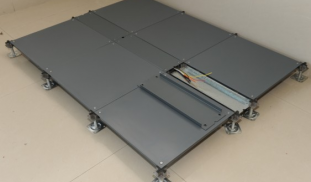Raised access floors have become an essential element in modern building design, offering a unique and effective solution for managing infrastructure and utilities. This flooring system creates a space above the building’s original floor, allowing for the easy routing of cables, wires, air conditioning ducts, and other services. Whether it’s for commercial, industrial, or office spaces, raised access floors provide flexibility, easy maintenance, and enhanced functionality.
What is a Raised Access Floor?
A raised access floor consists of panels placed above the original building floor, supported by adjustable pedestals that create a cavity or "plenum" underneath. The panels can be made from a variety of materials such as steel, aluminum, or wood, depending on the specific needs of the space. This raised gap beneath the floor provides a hidden space for utilities like electrical wiring, data cables, and HVAC systems.
One of the key features of raised access floors is their ability to provide easy access to these utilities without having to disrupt the building’s structure. The panels can be removed or replaced easily, allowing for quick adjustments, repairs, or upgrades to the system. This makes the raised access floor a highly adaptable and efficient solution for spaces that require frequent changes or additions to their infrastructure.
Key Advantages of Raised Access Floors
Raised access floors offer several distinct benefits, making them a popular choice in both new construction and renovation projects. One of the primary advantages is the flexibility they provide in terms of design and layout. With the ability to hide wiring and other utilities under the floor, businesses can easily change the layout of an office or workspace without dealing with the complexities of traditional wiring or construction.
This adaptability is particularly useful in environments where technology and infrastructure evolve rapidly, such as in data centers, server rooms, or control centers. As these environments require constant upgrades or modifications to their systems, raised access floors allow for easy reconfiguration of networks and systems, ensuring that the infrastructure remains up to date and efficient.
Another benefit of raised access floors is their ability to improve air circulation and temperature control. In environments where sensitive equipment needs to be kept cool, such as data centers, the cavity beneath the floor acts as a path for air to circulate, helping to regulate temperature and reduce overheating. This setup can also contribute to energy efficiency, as it allows for more effective management of HVAC systems.
Additionally, raised access floors provide a clean and organized solution for managing the vast amount of cables and wires that are often necessary in modern workplaces. This prevents the cables from becoming tangled, exposed, or creating a cluttered appearance. With everything neatly concealed beneath the floor, the space remains clean and aesthetically pleasing.
Where Are Raised Access Floors Used?
Raised access floors are most commonly found in commercial and industrial buildings, particularly in data centers, server rooms, telecommunications facilities, and control rooms. However, their use is not limited to these environments. Many modern office buildings, educational institutions, and healthcare facilities are incorporating raised access floors due to the growing need for flexible, easily adjustable workspaces and efficient management of utilities.
In high-traffic environments such as call centers or large offices, raised access floors allow businesses to easily add or change electrical outlets, network connections, and data ports without disrupting daily operations. This flexibility is especially useful in rapidly changing office layouts or for businesses that frequently update their technology.
Conclusion
Raised access floors are an indispensable feature in modern building infrastructure, offering a practical, flexible, and efficient way to manage utilities while maintaining a clean, organized, and aesthetically pleasing environment. Whether in high-tech industries, office spaces, or educational facilities, raised access floors provide the necessary adaptability for changing layouts, technological upgrades, and infrastructure improvements. With their ability to improve airflow, simplify maintenance, and enhance the overall functionality of a building, raised access floors are a valuable investment for any modern space.





Comments